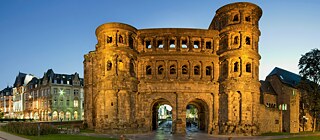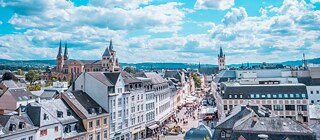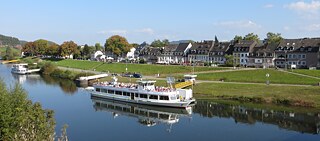Detours
Romans and other famous individuals

A holy robe, a black gate, Roman apple wine and some celebrity family history that hardly anyone knows about: do you need any more reasons to visit Trier?
By Jan Zipperer
Though the city of Trier certainly features in lessons at German schools, it is frequently overlooked as a travel destination: yet visiting Germany’s oldest city – which Trier itself claims to be, though in fact a number of German towns argue over the title – is definitely worthwhile!
The huge “Porta Nigra” city gate is an architectural wonder in itself: now the city’s landmark, it was built by the Romans in the second century AD. It was also the Romans who founded Trier in the year 16 BC, and their influence is still very much in evidence – besides numerous other buildings, such as the imperial baths, basilica and amphitheatre, they also brought wine to the region. As not everyone could afford it, poorer sections of the population used to like to drink Viez, a variety of apple wine. It can only be enjoyed properly when served in a special type of cup – a “Porz”. In many traditional restaurants and taverns along the Zurlaubener Ufer on the banks of the Mosel or in cult bars like the “Aom Ecken”, people still meet in the evenings to drink Viez from a genuine Viezporz.
What is more, Trier plays host every five years to the “Holy Robe Festival” to celebrate what is believed to be the last item of clothing worn by Jesus of Nazareth. This “holy robe” is said to have been taken from him by Roman soldiers after his crucifixion. Legend has it that the mother of the Roman Emperor Constantine the Great brought parts of the robe to Trier in the year 327. The holy robe is one of Trier Cathedral’s most precious treasures.
Another item of clothing also receives a lot of attention in Trier: the cap of Saint Simeon of Trier. He had himself walled into the city gate in the year 1030 so that he could live out a life of prayer there as a recluse. His cap of brown sheep’s wool remains preserved to this day.
Most Germans are taught at school that Trier is the birthplace of Karl Marx. The house where the social theorist and critic of capitalism was born can still be visited. What most teachers probably do not know, however, is that Karl Marx’s birth certificate, which was issued in 1818, was signed by the great-great-great-great-grandfather of the entertainer Günther Jauch. Trier’s deputy mayor at the time, his name was Emmerich Grach. He presumably could never have imagined how famous the new-born Marx would become, nor that his own descendant would one day be among the country’s most popular television personalities.
UMWEGE
What does Görliwood mean, why can you find a piece of the Caribbean in Bavaria and where can you dance in front of bucket wheel diggers? In our series we take you on a trip each month to somewhere in Germany that you may not yet know but should definitely be introduced to. We reveal places that are not to be found on the usual tourist trails. Are you ready for a bit of a detour?



